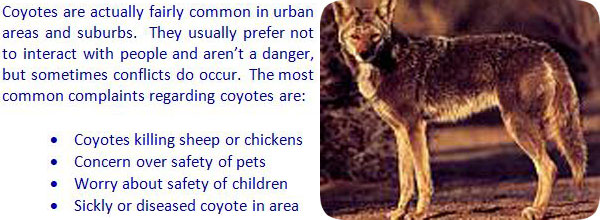- info@wildlifeanimalcontrol.com
Call us for help in your town
Wildlife Control Education
Coyote Trapping - How To Trap

Need coyote removal in your hometown? We service over 500 USA locations! Click here to hire us in your town and check prices - updated for year 2020.
How to set a trap
- Clean your trap to ensure no human smell remains on them. Boiling is recommended.
- Find coyote tracks to determine where they are getting in to the property.
- Pick a scent to lure them with. This can include coyote gland or urine. You can also use a small amount of meat.
- Dig a small hole and place and set the foothold trap. If you decide to use some meat, put it under the trap.
- If you are using a live cage trap, bait it with the lures and meat.
- Cover the trap carefully and make it look natural.
- Put about ten drops of the scent around the hole to attract the coyote.
- Release any animals caught that are not your target animal.
There are many people who will hunt coyotes with a gun, and because of their large population this can be a good way to thin the population in a certain area. Hunting can be a very time consuming way of dealing with coyotes, especially for people who have other things that they need to do. This is where the only other option is really to trap the animals. Different states will have different rules about what will need to be done with the coyote after it has been caught, with some insisting on euthanizing the animal, with other states having specific areas in which they can be released.
The trap that is used to hunt a coyote will need to be well sprung, as coyotes will often be trotting or running through an area, so a trap will have to be very quick to catch it. Although there are some traps that have been designed to kill coyotes, these are illegal in many areas because of the damage they can do to other animals and to humans if caught in the trap. This is why the traps used to catch coyotes should have rubber or flat metal jaws that will grip the animal firmly but not kill it. The traps should be laid away from areas where other animals and humans will go, and they should be checked a minimum of once a day.
Typical Coyote Behavior that Help With Trapping Strategy
One of the most common traits seen in coyotes is that they will often return to the carcass of an animal that they have already killed, either to continue eating from the carcass or to see if there is similar prey nearby. This is why laying traps in these areas will often have great success. Coyotes will generally stalk their prey, so if there has been a targeting of livestock by the animals then finding an entrance point to the field will often be the best place to locate a trap.
Types Of Trap
There are a number of different types of coyote trap available, with some people using cage traps and bait to catch the coyote, while others will choose to use a large snap trap that will close around the coyote and hold them until they are released or are able to escape.
One of the most disturbing things about using a snare trap to catch a coyote is that they will often be too scared to remain in the trap once daylight is approaching, and many will actually gnaw off a limb rather than remain captured. This will often lead to trappers retuning to an area where there is a lot of blood and the limb of a coyote. This will often prove fatal to the animal, and is one reason why checking of the traps in the early morning is recommended.
Summary
Coyotes will usually become a problem for humans once they start preying on chickens or other small livestock, but they are also known to scavenge from garbage. Coyotes are generally territorial animals that can cover large ranges, but if they find an abundant source of food then they will often return, which will be the best time to catch them.
More in-detail how-to coyote removal articles:
Information about how to kill a coyote - with poison or other methods.
Information about how to keep coyotes away - prevention techniques.
Information about how to catch a coyote - remove one stuck in the house.
Information about coyote repellent - analysis of types and effectiveness.
Coyotes are a type of canine that has been particularly successful and has spread across the majority of Central and North America. Despite the famous cartoon seeing a rivalry between a road runner and a coyote, road runners aren’t generally among the prey that a coyote will hunt. For the most part coyotes do not cause a very big problem, but there are situations where coyotes can come into conflict with humans, and this can often make it necessary to get rid of coyotes.
This site is intended to provide coyote education about how to trap a coyote in your house or property and and information about coyote trapping, so that you can make an informed decision if you need to deal with a coyote problem. This site provides many coyote control articles and strategies, if you wish to attempt to solve the problem yourself. If you are unable to do so, which is likely with many cases of coyote removal, please go to the home page and click the USA map, where I have wildlife removal experts listed in over 500 cites and towns, who can properly help you with your nuisance coyote.
Click here to read more about how to get rid of coyotes.

















